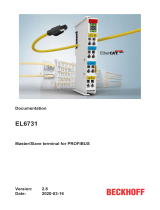
ORSG45 Table of contents
3
Table of contents
1 General information ................ 4
1.1 Safety symbols ......................... 4
1.2 Scope of delivery ....................... 4
1.3 Firmware history ....................... 4
1.4 Connections ........................... 4
1.4.1 Operating mode LED .............. 5
1.4.2 Status LED ..................... 5
1.4.3 PROFIBUS connector (DB9F) ........ 5
1.5 Terminating resistors .................... 5
1.6 Functional description ................... 7
1.7 Checking for the presence of the PROFIBUS
module .............................. 7
2 Data transmission .................. 8
2.1 General information .................... 8
2.2 Settings in the setup .................... 8
2.3 Analog channels ....................... 9
2.4 Math channels ......................... 9
2.5 Digital channels ........................ 9
2.6 Structure of the data for cyclic data transfer .. 10
2.6.1 Device → PROFIBUS master data
transmission ................... 12
2.6.2 PROFIBUS master → device data
transmission ................... 13
2.6.3 Slot overview ................... 15
2.6.4 Structure of the individual process
values ........................ 15
2.7 Acyclic data transfer ................... 17
2.7.1 Transferring texts ............... 17
2.7.2 Batch data .................... 17
2.7.3 Setting relays .................. 19
2.7.4 Changing limit values ............ 20
3 Integration into Simatic S7 ......... 23
3.1 Network overview ..................... 23
3.2 Hardware planning .................... 23
3.2.1 Installation and preparation ....... 23
3.2.2 Configuring the device as a DP slave .. 23
3.2.3 Transmitting the configuration ..... 24
3.3 Sample program ...................... 25
3.4 Acyclic access ........................ 25
3.4.1 Transmitting a text via Slot 0, Index
0 (see 2.7.1) ................... 27
3.4.2 Reading out the relay status via Slot
0, Index 2 (see 2.7.3 ) ............ 29
4 Troubleshooting .................. 30
4.1 Checking the measured value status
(PROFIBUS master → device) ............. 30
5 PROFIBUS DP troubleshooting ...... 31
6 List of abbreviations/definition of
terms ............................. 31
Index .................................. 32




















